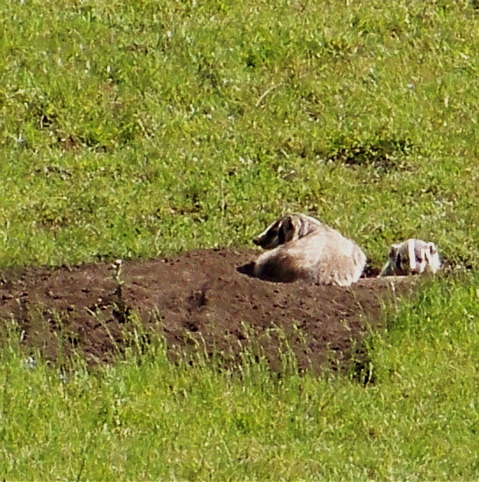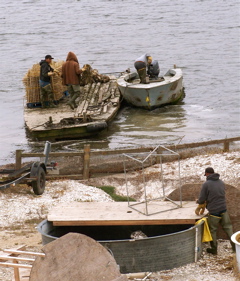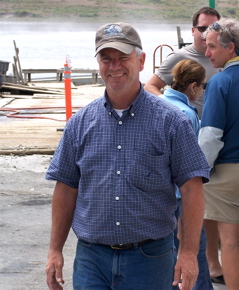Tue 26 May 2009
The purple couch beside the road
Posted by DavidMitchell under Photography
[4] Comments
My 22-year-old stepdaughter has never seen The Red Couch book, perhaps because it was published 25 years ago, yet last weekend on a lark she unknowingly echoed it while visiting West Marin. The Red Couch consists of photos of folks sitting on a red couch that had been taken to unlikely locales throughout the US, ranging from the floor of a stock exchange, to a desert, to an urban park. Here’s the story of the echo.
My stepdaughter Anika Zappa, who currently is working and going to college in Minneapolis, was my houseguest for five days this past week, and on Saturday she went shopping in Novato with her traveling companion Adam Pendergraft.
 While driving on Novato Boulevard between Hicks Valley and Stafford Lake, Anika was startled to see a purple couch abandoned on the shoulder of the road. (Since then I’ve heard from others who also saw it and were likewise surprised.)
While driving on Novato Boulevard between Hicks Valley and Stafford Lake, Anika was startled to see a purple couch abandoned on the shoulder of the road. (Since then I’ve heard from others who also saw it and were likewise surprised.)
The site seemed “very random,” she later told me, and the couch “was purple, so it totally caught my eye.”
When she drove back from Novato a couple of hours later, “I saw it again,” she said, “and I pulled over, jumped out, and shot a whole bunch of pictures of it.
“It was cool because the couch was purple; the pasture was green behind it; and blue skies.”
.

Anika Zappa and Adam Pendergraft in their roadside living room. You can see a few photos from The Red Couch Project, which Anika inadvertantly echoed, by clicking here. Unfortunately, using the site is trifle awkward, and its creator apparently doesn’t know the meaning of the word cliché, let alone how to spell it (regardless of the accent mark).
Although she is now attending college in Minnesota, Anika grew up in Guatemala where her mother and two sisters still live. In 2003, while all of us were living in Point Reyes Station, Anika at 16 began contributing writing and photography to The Point Reyes Light.
Her most-impressive contributions were shot in the Guatemala City airport. They sensitively documented the confused emotions of an injured Guatemalan laborer and of his family as he arrived home after being beaten nearly to death in Bolinas. The pictures were part of a series that in 2004 won top state and national honors for public service journalism.
She’s been a photographer ever since, and last semester, Anika proudly told me, “I Aced my photography class.”

Behind the couch on the shoulder of Novato Boulevard is Dave Lavaroni’s ranch. Passing motorists “were curious what we were doing,” Anika reported with amusement, “and probably thought we took the couch there.”
Saturday evening two more houseguests arrived at my cabin, Janine Warner and her husband Dave LaFontaine from Los Angeles. They are Internet-media consultants, and Janine herself was a prize-winning reporter at The Light 18 years ago.

As she posed on the couch, Anika noted, ‘people honked, and a truck came around twice to see what we were doing. A bicyclist yelled [encouragement].’
“I was showing Janine the photos I had taken that day,” Anika said. “We were talking about what kind of photography interests me, and I said ‘composition.’ And she said, ‘What would you do with this couch?’ I said I just bought a yellow dress, and I’d put someone in a yellow dress on it, with a lamp and some flowers.
“She was intrigued and said, ‘Let’s do it tomorrow.’ I really didn’t think it would go. I thought we’d be busy with something else. I had just met her, so I didn’t know if it was a ‘Let’s go’ for real,” Anika later admitted.
But the next morning, Janine said, “When are we shooting the couch?” and the two of them, along with Adam and Dave, “started doing a scavenger hunt around the house for props. We started thinking about the colors.”
Anika has studied photography at San Marin High, as well as in college, and in choosing props, she said, “one thing that helped a lot is that in both photography classes, the first thing we did was work with a color wheel.”

Janine Warner and Dave LaFontaine take a break from Saturday’s photo shoot. Janine took all the photos here except this one while Dave helped with setups.
Janine said, “‘You have the yellow dress. This can be a self-portrait.’ She let my creative mind go.” Janine’s husband Dave is an old hand at setting up photo shoots, and eventually all three were brainstorming about the project.
After shooting a number of photos that made use of the couch as it was placed, “Adam and I moved the couch around, so we could get a view of the road as well,” Anika noted, explaining that what made the scene interesting was the couch’s being beside Novato Boulevard.

Anika later laughed about having to contend with a “wardrobe malfunction” (one strap to her new dress broke) as she struck various poses on the couch.
The shoot took about an hour and a half, “and the sun was perfect because it was not too bright,” Anika said.
“I had a good time doing it and letting my creative side out. And it was fun being on both sides of the lens.” When the photos were later downloaded onto a computer, she added, “it was awesome seeing on the screen the thing I had in my head.”



 I’ve see badgers for sale as food in a Guangzhou, China, marketplace. And badgers were once a staple of the Native American, as well as colonial, diet. Even today they’re commonly eaten in France, Russia, and other European countries, as well as China.
I’ve see badgers for sale as food in a Guangzhou, China, marketplace. And badgers were once a staple of the Native American, as well as colonial, diet. Even today they’re commonly eaten in France, Russia, and other European countries, as well as China. In 2007, Marin County supervisors asked Senator Dianne Feinstein (right) to intervene after the Point Reyes National Seashore administration began harassing the oyster company.
In 2007, Marin County supervisors asked Senator Dianne Feinstein (right) to intervene after the Point Reyes National Seashore administration began harassing the oyster company. The conflict began with an
The conflict began with an  The first exposure occurred in July 2008 when the Inspector General’s Office of the Interior Department issued a
The first exposure occurred in July 2008 when the Inspector General’s Office of the Interior Department issued a  “That really is a policy and law issue,” said Jarvis (right), “not a science issue.”
“That really is a policy and law issue,” said Jarvis (right), “not a science issue.”